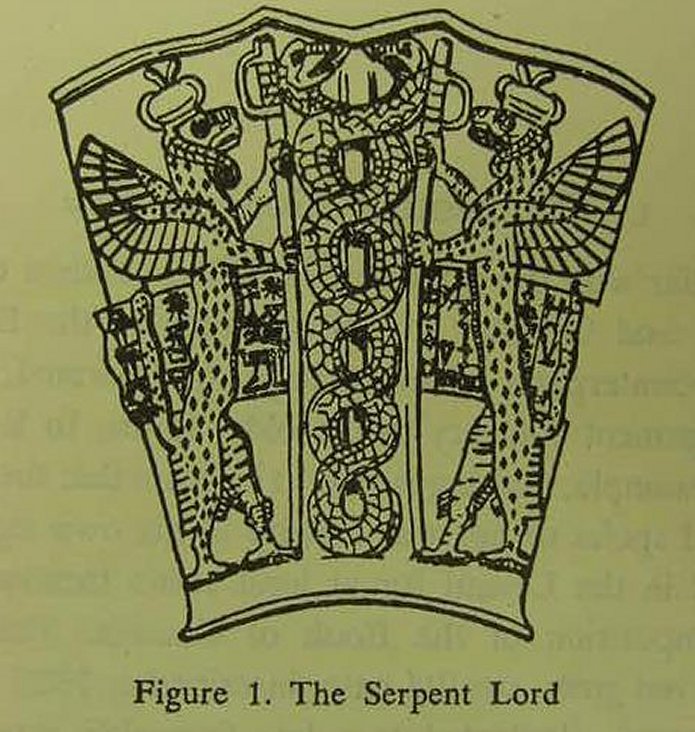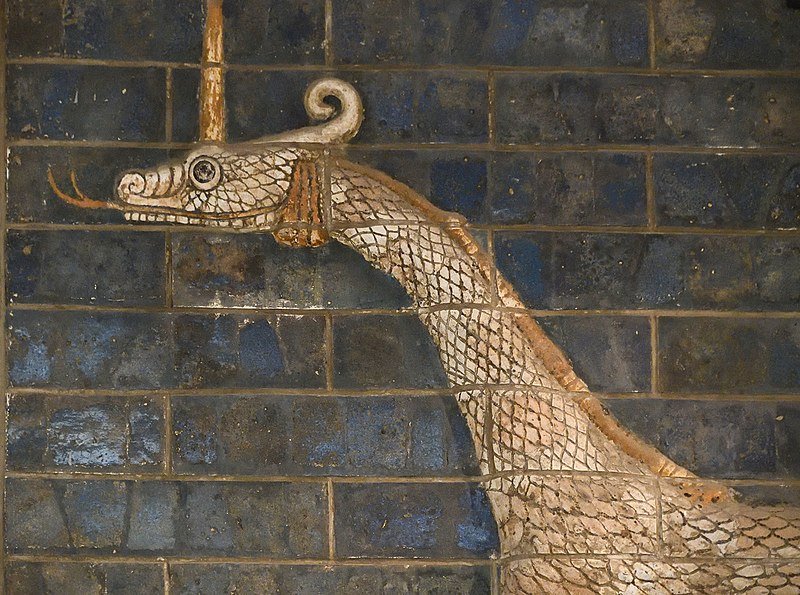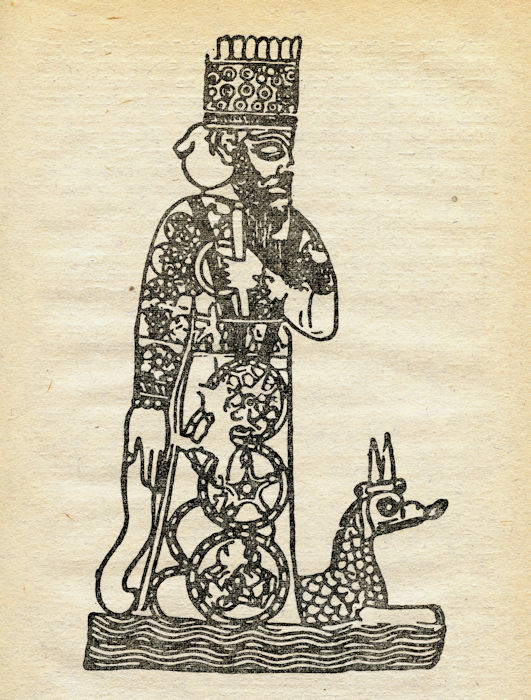Sirrush – Powerful “Glamorous Snake” Guarded Marduk But Did This Hybrid Really Exist?
A. Sutherland - AncientPages.com - Sirrush (Mushrush, Mushrushu) is a hybrid creature depicted on the Ishtar gate in Babylon. It resembles a dragon or a griffin, and it is the most famous image of this creature, displayed on the walls and gates of the procession path in Babylon.
Ningizzida in the middle, followed by the dragon Mushussu. Stone vase work "libation vase of Gudea". Image source - Public Domain
Sirrush has a horned snakehead, a scaly snake body, a long neck, a long tail, and scales. The slim scaly neck has the head of a serpent with a horn and a long forked tongue.
Because the tiles show a side view, only one horn can be seen, but two horns are clearly shown in other depictions. Flaps of skin cover the ears.
The creature's feet were remarkable and somewhat unusual. The forefeet being those of a feline, perhaps a leopard or a panther. On the other hand, the hind feet were large and birdlike, with four toes covered with scales.
This animal is identical to the dragons guarding Marduk and is considered one of his symbols.
The name 'sirrush' originates from the Akkadian word, roughly translated as a 'magnificent serpent.' The early researchers probably misread the title, and since then, "sirrush" has been used as the most common name for this creature. Other variations of its name include Mushussu ("the furious snake"), Musrussu dragon, and Sirrušu.
Mušḫuššu dragon in Istanbul Ancient Orient Museum Ishtar Gate. Image credit: Dosseman - CC BY-SA 4.0
The German archaeologist Robert Koldewey, who found the Ishtar Gate during his excavations from 1899 until 1917, was convinced that the 'Sirrush' existed.
He argued that in terms of the uniformity of his physiological concept, 'Sirrush' significantly surpasses all other legendary creatures.
The fact that 'Sirrushi' was depicted next to real animals (for example, lions), according to Koldewey, proved that the Babylonians were familiar with this creature, mentioned in ancient Mesopotamian mythology. One theory suggested that the Babylonians could copy the appearance of the Sirrush from the remains of prehistoric lizards, mainly because the animal resembles the so-called monitor lizards, which could be known to the Babylonians.
According to theories, the Sirrush's appearance was based on ancient stories about an animal that did not live in Mesopotamia.
According to written sources, the Sirrush was initially an animal of Ninazu, the god of Eshnunna (an ancient Sumerian and later Akkadian city and city-state in central Mesopotamia).
Marduk and his dragon Sirrush. Credit: Adobe Stock - Juulijs
In the Akkadian or early Babylonian times (18th century BC), this fantastic mythological hybrid animal was related to the god Tishpak, who replaced the guardian god of the city with this creature. In Lagash, on the other hand, he began to be associated with the son of Ninazu, the god Ningishida.
One of the most significant Babylonian-Assyrian gods, Nabu, was said to be the keeper of the tablet of fate regarding the ancient Babylonians and Assyrians.
He used to ride on a winged dragon known as Sirrush that initially belonged to his father, Marduk.
The Sirrush was referred to in Babylonian cuneiform inscriptions as Musrussu, meaning "Glamorous Snake" or "Splendor Serpent." The creature was identified with the mythical serpent-dragon mushkhushshu (or mushushu). This identification was significantly possible thanks to the texts from the inscriptions of King Nebuchadnezzar II.
These texts were devoted to construction work in Babylon conducted by this great ruler of ancient Babylonia and conquerer of Judah. With time, the Sirrush was transferred to Assyria and associated with the local state god Ashur, an equivalent of Enlil.
Written by – A. Sutherland - AncientPages.com Senior Staff Writer
Updated on May 6, 2024
Copyright © AncientPages.com All rights reserved. This material may not be published, broadcast, rewritten or redistributed in whole or part without the express written permission of AncientPages.com
Expand for referencesReferences:
Kriwaczek P., Babylon: Mesopotamia and the Birth of Civilization
Enthralling History, Ancient Mesopotamia
More From Ancient Pages
-
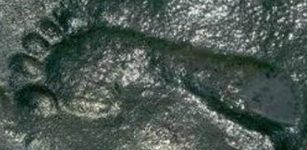 Mystery Of The 290-Million-Year-Old Zapata Footprint In New Mexico
Featured Stories | Sep 23, 2020
Mystery Of The 290-Million-Year-Old Zapata Footprint In New Mexico
Featured Stories | Sep 23, 2020 -
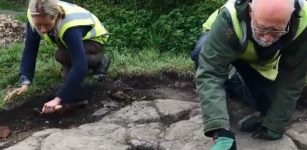 Uncovering 16th Century Scottish Royal Dockyards Used By King James IV’s Navy
Archaeology | May 24, 2018
Uncovering 16th Century Scottish Royal Dockyards Used By King James IV’s Navy
Archaeology | May 24, 2018 -
 Archimedes From Syracuse – Master Of Science Whose Legacy Still Remains Powerful
Featured Stories | Sep 20, 2017
Archimedes From Syracuse – Master Of Science Whose Legacy Still Remains Powerful
Featured Stories | Sep 20, 2017 -
 Did Crassus, Ancient Rome’s Wealthiest Man Really Die From Drinking Molten Gold?
Featured Stories | Feb 15, 2017
Did Crassus, Ancient Rome’s Wealthiest Man Really Die From Drinking Molten Gold?
Featured Stories | Feb 15, 2017 -
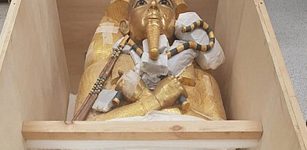 King Tutankhamun’s Large Golden Coffin Was Moved For Restoration
Archaeology | Jul 18, 2019
King Tutankhamun’s Large Golden Coffin Was Moved For Restoration
Archaeology | Jul 18, 2019 -
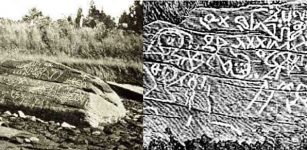 Dighton Rock – Centuries-Old-Mystery Still Unsolved
Featured Stories | Sep 8, 2015
Dighton Rock – Centuries-Old-Mystery Still Unsolved
Featured Stories | Sep 8, 2015 -
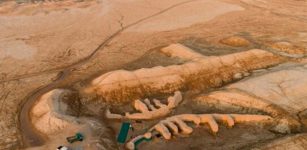 Sumerians Built A Huge ‘Anti-Drought Machine’ To Save Ancient City Of Girsu From Destruction
Ancient Technology | Nov 23, 2023
Sumerians Built A Huge ‘Anti-Drought Machine’ To Save Ancient City Of Girsu From Destruction
Ancient Technology | Nov 23, 2023 -
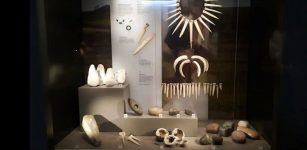 Ancient Goldsmith’s Toolkit Discovered Near Stonehenge
Archaeology | Dec 16, 2022
Ancient Goldsmith’s Toolkit Discovered Near Stonehenge
Archaeology | Dec 16, 2022 -
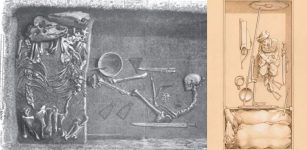 Birka Warrior Was A Woman – DNA Reveals
Archaeology | Feb 15, 2018
Birka Warrior Was A Woman – DNA Reveals
Archaeology | Feb 15, 2018 -
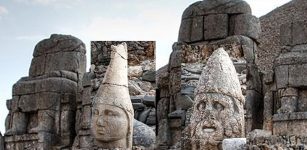 Mount Nemrut: ‘Throne Of The Gods’ – Mysterious Royal Tomb Surrounded By Gigantic Sculptures
Civilizations | Nov 16, 2018
Mount Nemrut: ‘Throne Of The Gods’ – Mysterious Royal Tomb Surrounded By Gigantic Sculptures
Civilizations | Nov 16, 2018 -
 Chang’e: Chinese Goddess Of Moon And Immortality
Chinese Mythology | Aug 7, 2019
Chang’e: Chinese Goddess Of Moon And Immortality
Chinese Mythology | Aug 7, 2019 -
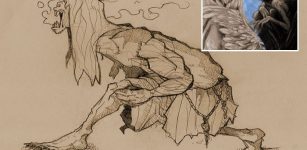 Strzyga (Strix): Slavic Malevolent Winged Female Demon With Two Souls That Usually Haunts Churches, Towers, Barns
Featured Stories | Aug 9, 2019
Strzyga (Strix): Slavic Malevolent Winged Female Demon With Two Souls That Usually Haunts Churches, Towers, Barns
Featured Stories | Aug 9, 2019 -
 4,000-Year-Old Serpent-Shaped Wooden Stick Unearthed in Southern Finland
Archaeology | Jun 30, 2021
4,000-Year-Old Serpent-Shaped Wooden Stick Unearthed in Southern Finland
Archaeology | Jun 30, 2021 -
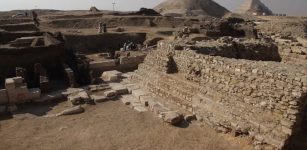 Pyramid Of Unknown Ancient Egyptian Queen And Hundreds Of Mummies Discovered In Saqqara
Archaeology | Nov 17, 2022
Pyramid Of Unknown Ancient Egyptian Queen And Hundreds Of Mummies Discovered In Saqqara
Archaeology | Nov 17, 2022 -
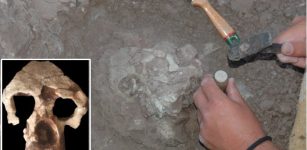 New Fossil Ape Challenges The Story Of Human Evolution
Evolution | Aug 24, 2023
New Fossil Ape Challenges The Story Of Human Evolution
Evolution | Aug 24, 2023 -
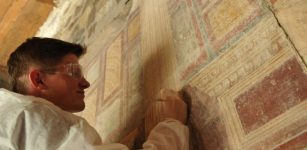 Poles conduct mural restoration in the villa buried by the ashes of Vesuvius
News | Aug 26, 2015
Poles conduct mural restoration in the villa buried by the ashes of Vesuvius
News | Aug 26, 2015 -
 Megaliths In Central France: 30 Prehistoric Monolith Stones And One Human Skeleton – Unearthed
Archaeology | Sep 11, 2019
Megaliths In Central France: 30 Prehistoric Monolith Stones And One Human Skeleton – Unearthed
Archaeology | Sep 11, 2019 -
 Unique Life-Sized Camel Carvings In Northern Arabia Are Much Older Than Previously Thought
Archaeology | Sep 15, 2021
Unique Life-Sized Camel Carvings In Northern Arabia Are Much Older Than Previously Thought
Archaeology | Sep 15, 2021 -
 Stunning Reconstruction Of Caterthun Iron Age Forts In The Grampian Mountains, Scotland
Civilizations | Nov 17, 2016
Stunning Reconstruction Of Caterthun Iron Age Forts In The Grampian Mountains, Scotland
Civilizations | Nov 17, 2016 -
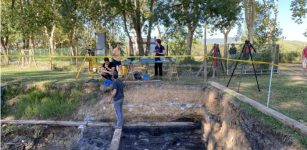 Well-Preserved 7,300-Year-Old Wooden Cabins Discovered In La Draga
Archaeology | Oct 23, 2023
Well-Preserved 7,300-Year-Old Wooden Cabins Discovered In La Draga
Archaeology | Oct 23, 2023

